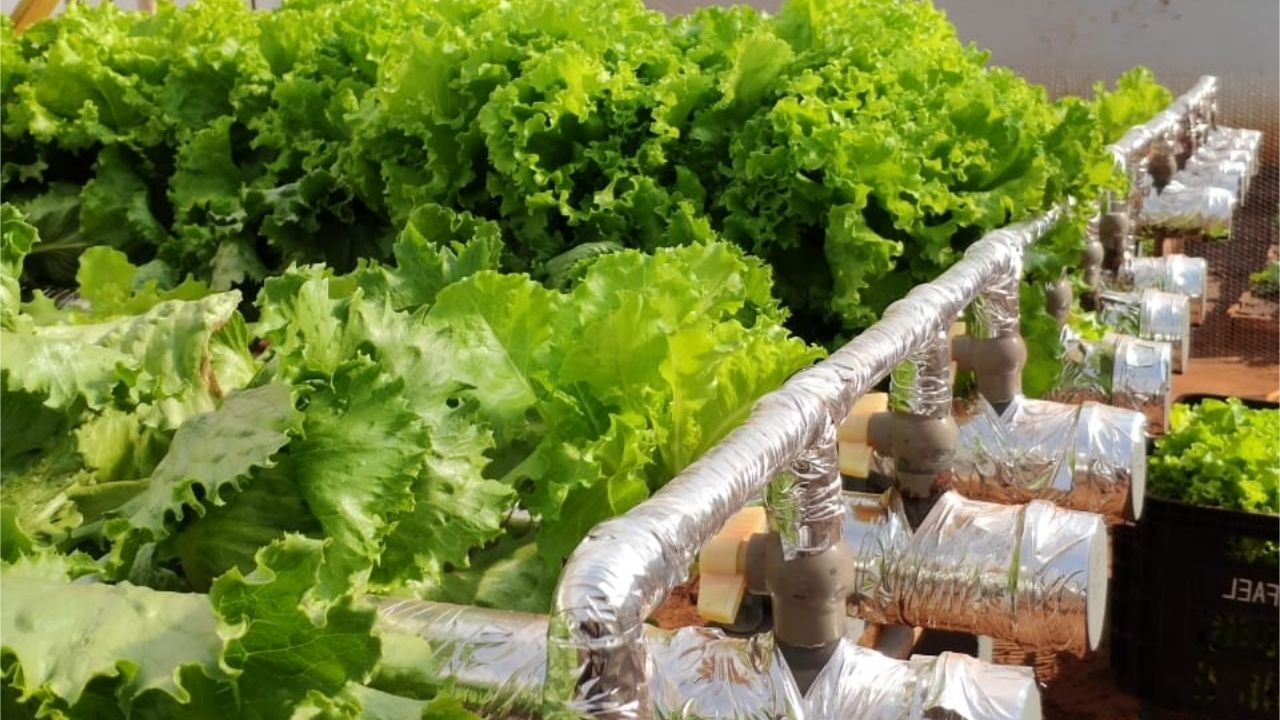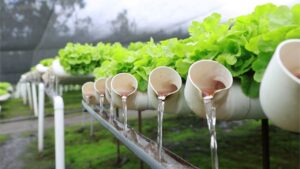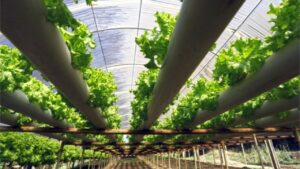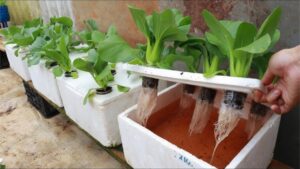In recent years, hydroponic gardens have gained increasing popularity, especially in urban environments. This innovative growing technique, which eliminates the need for soil and uses a nutrient solution to nourish plants, has proven to be an effective solution for those wanting to grow fresh food in limited spaces, such as apartments or balconies. With the growing concern for sustainability and the search for healthier alternatives, hydroponic gardens offer a practical and efficient way to produce food at home without the need for large areas or pesticides.
Using fresh, homegrown ingredients not only enhances the flavor of your dishes but also provides numerous health benefits. Fresh foods are rich in essential nutrients and contain significantly fewer preservatives and chemicals compared to store-bought products. Moreover, homegrown produce ensures that you have access to vegetables and herbs with maximum flavor and quality, directly from your garden to your table.
In this post, we’ll explore some easy and delicious recipe ideas that you can prepare using fresh ingredients from your hydroponic garden. Whether for a light meal or a healthy snack, these recipes are perfect for anyone looking for a healthier, tastier, and more sustainable diet. Let’s dive in!
Benefits of Using Ingredients from Your Hydroponic Garden
Using fresh, homegrown ingredients can have a significant impact on your health. Fresh foods are rich in vitamins, minerals, and essential nutrients that are often lost during transportation and storage of store-bought products. For example, leafy greens like lettuce, arugula, and spinach, commonly grown in hydroponic gardens, are excellent sources of vitamins A, C, and K, as well as minerals like iron and calcium. By consuming these ingredients directly from your garden, you ensure that they are at their freshest and most nutritious.
In addition, growing your own food offers a variety of benefits. One of the biggest advantages is complete control over the growing process. You can choose the types of plants you want to grow, such as those that meet your nutritional and dietary preferences, and ensure they are cultivated without the use of pesticides or chemicals. This not only results in healthier food but also helps reduce your exposure to unwanted toxins. Another important benefit is sustainability: by growing your own ingredients, you reduce the need for plastic packaging and the environmental impact caused by transporting food over long distances, making your diet more eco-friendly.
So, what exactly is a hydroponic garden? In short, it is a system for growing plants without soil, where the plant roots are immersed in a nutrient-rich water solution. This method allows plants to grow efficiently in small spaces, such as apartments, balconies, or even indoors. Hydroponic gardening not only maximizes the use of urban space but also accelerates plant growth and improves the quality of vegetables since they receive exactly what they need to thrive. This makes it an excellent option for anyone looking to harvest fresh and nutritious food year-round, regardless of the space available.
Common Ingredients in a Hydroponic Garden
One of the biggest advantages of having a hydroponic garden at home is the variety of fresh and healthy ingredients you can grow, even in small spaces. Below are some of the most common ingredients that can be successfully grown in a hydroponic system, providing a delicious and nutritious base for your recipes.
Herbs Herbs like basil, mint, parsley, and cilantro are perfect for hydroponics. They grow quickly and are extremely versatile in the kitchen, adding flavor and freshness to a wide variety of dishes. Basil is essential in Italian dishes, such as the famous pesto sauce, while mint can be used in refreshing drinks like iced teas or smoothies. Parsley and cilantro, on the other hand, are great for seasoning salads, soups, and even meat dishes.
Leafy Greens Leafy greens are the cornerstone of any hydroponic garden. Lettuce, arugula, spinach, and watercress are easy to grow and provide an abundance of essential nutrients such as fiber, vitamins A and C, and minerals like iron. These greens are perfect for fresh salads but can also be used in sandwiches, wraps, or even juices and smoothies. The big advantage of hydroponically grown greens is their crisp texture and vibrant flavor, as they are harvested at their peak freshness.
Vegetables Vegetables like cucumbers, tomatoes, and peppers also adapt well to hydroponics. Cucumbers are refreshing and perfect for salads or even for making homemade pickles. Hydroponically grown tomatoes tend to be sweeter and juicier, ideal for sauces, salads, or sandwiches. Peppers, in turn, add color and flavor to a variety of dishes, and they are an excellent source of vitamin C. These vegetables are perfect for anyone wanting a more diverse and productive garden.
Microgreens and Sprouts Microgreens and sprouts are another highlight of hydroponic gardens. They grow quickly and can be harvested in just a few days, offering an extra touch of flavor and nutrition. Microgreens like broccoli, mustard, and radicchio are rich in antioxidants, while sprouts like alfalfa, lentil, and mung bean are powerful sources of protein and fiber. These ingredients are great for adding to salads, sandwiches, wraps, or even as garnishes for main dishes.
With these fresh ingredients at your fingertips, the possibilities for creating healthy and delicious dishes are virtually endless. Growing these items in your own hydroponic garden not only guarantees superior flavor but also allows you to harvest food at its most nutritious moment, straight from your garden to your table.
5 Healthy Recipe Ideas Using Ingredients from Your Hydroponic Garden
Now that you know the benefits and fresh ingredients from your hydroponic garden, it’s time to get cooking! Here are 5 simple and delicious recipes you can prepare using ingredients straight from your garden.
1. Mixed Green Salad with Yogurt and Herb Dressing
Ingredients:
- Lettuce
- Arugula
- Basil
- Plain yogurt
- Olive oil
- Lemon
- Salt and pepper
Instructions:
- Wash the lettuce and arugula thoroughly, then chop them into small pieces.
- Slice the basil into thin strips and add it to the greens.
- In a bowl, mix the plain yogurt, olive oil, lemon juice, salt, and pepper. Stir until the dressing is smooth.
- Pour the dressing over the greens and toss gently.
- Serve immediately as a fresh and nutritious salad, perfect for any meal.
2. Green Detox Smoothie
Ingredients:
- Spinach
- Cucumber
- Green apple
- Lemon
- Ginger
- Coconut water
Instructions:
- Wash the spinach and cucumber well. Cut the green apple and remove the seeds.
- In a blender, combine the spinach, cucumber, apple, lemon juice, ginger, and coconut water.
- Blend until smooth and creamy.
- Pour into glasses and enjoy the detoxifying and energizing benefits of this smoothie.
3. Lettuce Wrap with Grilled Chicken and Herb Yogurt Sauce
Ingredients:
- Lettuce leaves
- Chicken breast
- Olive oil
- Yogurt herb sauce
Instructions:
- Grill the chicken breast in a skillet with olive oil until golden and cooked through.
- While the chicken is grilling, wash and dry the lettuce leaves, which will serve as the base for the wraps.
- Slice the chicken into strips and place over the lettuce leaves.
- Drizzle with the yogurt herb sauce (made with plain yogurt, basil, olive oil, lemon, salt, and pepper).
- Fold the ends of the lettuce leaves and roll, forming the wrap.
- Serve as a healthy and light snack.
4. Cold Cucumber and Yogurt Soup
Ingredients:
- Cucumber
- Yogurt
- Garlic
- Olive oil
- Lemon
- Salt and pepper
Instructions:
- Wash and slice the cucumber into thin slices.
- In a blender, combine the cucumber, yogurt, minced garlic, olive oil, lemon juice, salt, and pepper.
- Blend until smooth and well combined.
- Serve the soup cold as a light and refreshing option for hot days.
5. Vegan Sandwich with Whole Wheat Bread, Avocado, and Sprouts
Ingredients:
- Whole wheat bread
- Avocado
- Tomato
- Alfalfa sprouts
- Olive oil
- Lemon
- Salt
Instructions:
- Toast the slices of whole wheat bread until crispy.
- Cut the avocado in half, remove the pit, and mash the flesh with a fork. Add a bit of olive oil, lemon juice, and salt to taste.
- Spread the mashed avocado on the toasted bread slices.
- Add slices of tomato and alfalfa sprouts on top.
- Assemble the sandwich and serve as a simple and tasty option for a healthy snack.
These recipes are perfect for incorporating the fresh ingredients from your hydroponic garden into your daily routine, providing quick, nutritious, and delicious meals. Enjoy!
- See Also: Technologies That Are Revolutionizing Hydroponic Gardens in the City
- Follow Us: https://www.facebook.com/profile.php?id=61565415975218
How to Store Ingredients from Your Hydroponic Garden
After harvesting fresh ingredients from your hydroponic garden, it’s important to know how to store them properly to extend their shelf life and maintain their quality and freshness for longer. Here are some helpful tips to ensure your herbs and vegetables stay fresh and nutritious until your next meal.
Tips to Extend the Shelf Life of Herbs and Vegetables
Herbs:
- Hydration: Many herbs, like basil and mint, can be stored in water, just like flowers. Place the stems in a glass of water and cover the leaves with a plastic bag. Keep the glass in a cool spot, such as a windowsill or countertop, to keep the herbs fresh for several days.
- Refrigeration: Other herbs, like parsley, cilantro, and thyme, can be stored in the fridge. Place them in an airtight container or wrap them in a damp cloth inside a plastic bag to prevent them from drying out.
- Freezing: For herbs like rosemary, oregano, and basil, freezing is a great option. Chop them up and place them in an ice cube tray with a bit of olive oil, then freeze. This way, you can use the herbs over time.
Leafy Greens:
- Wash and Dry: Before storing lettuce, arugula, spinach, or other leafy greens, wash them thoroughly to remove any nutrient residue. Dry them gently using a clean dish towel or a salad spinner to prevent wilting or excess moisture.
- Paper Towels and Airtight Container: To keep the greens fresh for longer, place them in an airtight container with a layer of paper towels. The paper towels help absorb excess moisture and prevent the leaves from wilting.
- Refrigeration: Store the greens in the coldest part of your fridge to ensure they stay crisp and fresh for several days.
Vegetables (Tomatoes, Cucumbers, Peppers):
- Room Temperature for Tomatoes: Tomatoes should be stored at room temperature to preserve their flavor and texture. Place them in a container, preferably out of direct light, to avoid them ripening too quickly.
- Refrigeration for Cucumbers and Peppers: While cucumbers and peppers can be kept at room temperature for a short time, it’s best to store them in the fridge to extend their shelf life. Place them in a plastic bag or container that allows airflow to prevent excess moisture, which can speed up decay.
Microgreens and Sprouts:
- Refrigeration: Microgreens and sprouts should be stored in the fridge right after harvesting. Use a container with a lid or a plastic bag to keep them cool, but not completely sealed, as they need some ventilation to prevent wilting.
- Avoid Moisture: To keep microgreens crisp, avoid excess moisture, as it can cause rapid decay. Use paper towels to absorb any moisture if necessary.
How to Store Correctly to Keep Ingredients Fresh for Longer
The key to extending the shelf life of your hydroponic garden ingredients is ensuring they remain in the right environment. In addition to storing them at the ideal temperatures, it’s important to avoid moisture buildup, which can accelerate the decay process. Using the right containers, like plastic bags or airtight jars, can help control moisture and keep ingredients fresh for longer.
Another helpful tip is to organize your fridge so that more sensitive ingredients are kept on the upper shelves, where the temperature is more consistent. And, of course, always check the condition of your vegetables regularly, removing any leaves or pieces that are starting to wilt or rot to prevent them from contaminating the other ingredients.
By following these simple practices, you’ll be able to make the most of the fresh foods from your hydroponic garden and enjoy flavorful and healthy meals for longer.
Tips to Improve Your Hydroponic Garden and Maximize Your Harvest
Growing a hydroponic garden at home is an efficient and sustainable way to have fresh food at your fingertips. To ensure that your garden yields an abundant and healthy harvest, there are some key practices and tips that can make all the difference. Here are the essential tips to improve your hydroponic garden and maximize results.
How to Choose the Best Vegetables and Herbs for Hydroponic Cultivation
Choosing the right vegetables and herbs is one of the first steps to ensuring the success of your hydroponic garden. Some plants adapt better to this type of cultivation, while others may perform less well. Here are some ideal options for hydroponic cultivation:
- Herbs: Basil, mint, parsley, chives, and cilantro are among the easiest herbs to grow hydroponically. They grow quickly and don’t require much space, making them perfect for small hydroponic systems.
- Leafy Greens: Lettuce, arugula, spinach, and watercress are excellent choices for hydroponic cultivation. These plants not only grow well without soil, but also have high water and nutrient needs, which a hydroponic system can efficiently provide.
- Vegetables: Vegetables like cucumber, tomato, pepper, and zucchini can also be grown hydroponically. However, it’s important to ensure you have enough space, especially for larger plants like tomatoes and cucumbers.
Basic Maintenance and Care to Ensure an Abundant and Healthy Harvest
Maintaining your hydroponic garden requires a bit of daily attention, but with simple care, you can maximize production and keep your plants healthy. Here are some essential care tips:
- Check the water regularly: Water is the heart of the hydroponic system. Ensure that the water level is always adequate and that the nutrient solution is refreshed regularly. Avoid stagnant water, as it can negatively affect plant growth.
- Clean the system: Periodically clean the hydroponic system, including tubes, reservoirs, and pots. This prevents the buildup of algae or debris that could block nutrient flow and harm plant health.
- Pest and disease control: While hydroponics reduces the risk of soil pests, insects or fungi may still appear. Use natural control methods, such as organic pesticides or traps, to keep your garden healthy.
- Regular pruning: Pruning helps direct the plant’s energy toward leaf and fruit growth. Remove any dead or damaged leaves, and strategically prune plants to optimize their growth.
The Importance of Lighting, pH of Water, and Nutrients for Garden Success
Lighting: Light is essential for photosynthesis, which drives plant growth. If you grow your garden indoors, it’s important to ensure your plants get enough light. Use LED grow lights, which are efficient and provide the necessary light spectrum for healthy growth. Ensure your plants receive between 12 to 16 hours of light per day, depending on the type of plant.
pH of water: Regularly monitor the pH of the water, as it affects how well plants absorb nutrients. The ideal pH for most hydroponic plants is between 5.5 and 6.5. If the pH is outside of this range, nutrients may not be absorbed efficiently, hindering growth. Use pH test kits, and if necessary, adjust the pH with specific products to keep the nutrient solution balanced.
Nutrients: Providing the right amount of nutrients is crucial for plant development. Use nutrient solutions specifically formulated for hydroponic cultivation, which contain the macronutrients (nitrogen, phosphorus, potassium) and micronutrients (iron, manganese, zinc) necessary for healthy growth. Be sure to refresh the nutrient solution regularly and adjust its concentration according to the plant’s growth stage.
By following these care and maintenance tips, your hydroponic garden will be well-equipped to provide a healthy and abundant harvest. Investing time and attention to the details of your system will ensure your plants grow strong and produce fresh, flavorful food.
Conclusion:
Now that you know the benefits and essential practices for a successful hydroponic garden, it’s the perfect time to start or expand your own garden at home.
Having access to fresh, pesticide-free ingredients not only benefits your health but also the environment, promoting a more sustainable lifestyle. Additionally, cultivating a hydroponic garden is a practical and efficient way to use urban spaces to grow food that might have previously seemed out of reach.
So, why not put some of the healthy recipes we shared into practice? Try making fresh salads, energizing smoothies, or delicious wraps using ingredients grown from your hydroponic garden. Don’t forget to share your own creations and discoveries! We’d love to see how your garden is growing and how you’re enjoying your fresh produce in tasty and nutritious dishes.
Start today and enjoy the benefits of a hydroponic garden. Your health and taste buds will thank you!




